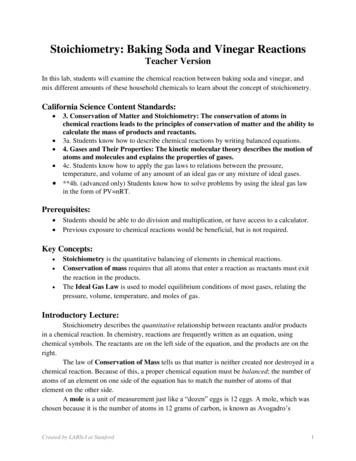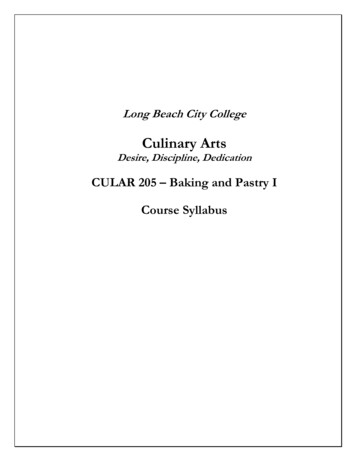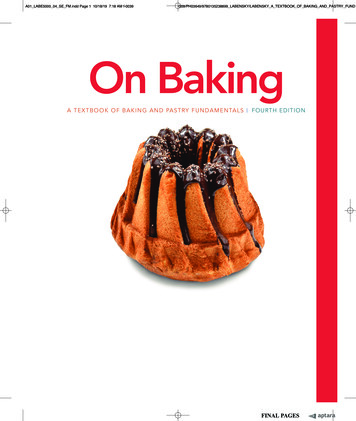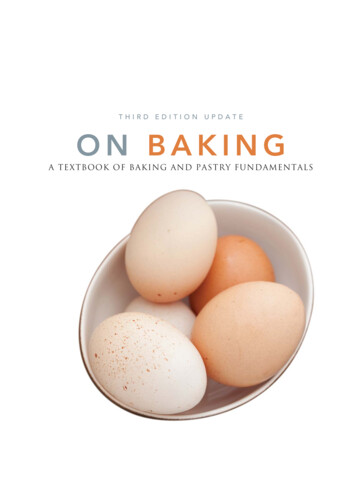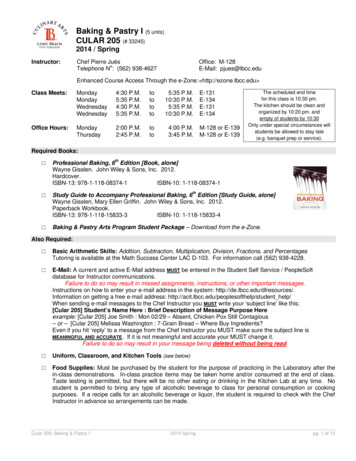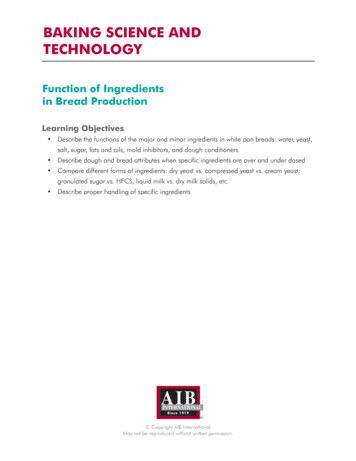
Transcription
BAKING SCIENCE ANDTECHNOLOGYFunction of Ingredientsin Bread ProductionLearning Objectives Describe the functions of the major and minor ingredients in white pan breads: water, yeast,salt, sugar, fats and oils, mold inhibitors, and dough conditioners Describe dough and bread attributes when specific ingredients are over and under dosed Compare different forms of ingredients: dry yeast vs. compressed yeast vs. cream yeast;granulated sugar vs. HFCS, liquid milk vs. dry milk solids, etc. Describe proper handling of specific ingredients Copyright AIB InternationalMay not be reproduced without written permission.
Function of Ingredientsin Bread ProductionBAKING SCIENCE AND TECHNOLOGYBaking bread begins with combining the appropriate ingredients asoutlined in a formula. Bakers combine various ingredients to makea wide variety of breads. Selecting the right ingredients makes thedifference between producing excellent breads and poor qualitybreads. Any significant change in ingredients will affect the finalproduct quality and customer satisfaction. A strong understandingof how individual ingredients function and how they interact in adough system is critical.The most basic and ancient bread formulas consist of flour, water,salt, and yeast. From that basic formula, thousands of varieties havebeen created. Breads may include ingredients such as milk, eggs,various fats, fruits, nuts, sweeteners, etc.Wheat and FlourWheat flour dough has the unique ability to retain the gas producedduring yeast fermentation or by chemical leavening. The flour isresponsible for the characteristic structure of bakery foods. Wheatflour is made from one or blends of six classes of wheat: durum,hard red spring, hard red winter, hard white, soft red winter, andsoft white.Wheat ClassDurumHard Red Spring (HRS)Hard Red Winter (HRW)Hard White (HW)Soft Red Winter (SRW)Soft White (SW)Avg WheatProtein %14-16%13-14%11-12%11-12%10%10%Typical UsesPastas, spaghetti, macaroniPan breads, rolls, bunsPan breads, artisan breads and rolls, pizza crustsNoodles, flat breads, breadsCakes, pastries, biscuits, crackersAsian noodles, flat breads, cakes, pastries, crackersWinter wheats are planted in the fall, germinate and begin togrow, and then become dormant during the cold winter months.They resume growth in the spring and are harvested during theearly summer. For winter wheat to produce seed, it must undergotemperatures near freezing for several days. If the wheat does notencounter the cold, the plants become a grass and do not formkernels. This type of wheat grows in regions where the winters aremoderate and relatively dry.2 Copyright AIB InternationalMay not be reproduced without written permission.
BAKING SCIENCE AND TECHNOLOGYFunction of Ingredientsin Bread ProductionSpring wheats are planted in the spring and harvested in latesummer. Spring wheats are grown in regions where winters aresevere, and also in regions where winters are mild. Spring wheatsgenerally have higher protein contents than do winter wheats (forhard spring and hard winter). There is an inverse relationshipbetween grain yield and protein content of the grain; hard springwheats have a lower yield of grain per acre than hard winterwheats.The terms “red” and “white” indicate the color of the wheat kernel,not the flour milled from the wheat. The color comes from a singlelayer of cells in the pericarp. Red wheat is pigmented, and white isnot. The color component contributes a bitter or astringent flavor tothe bran and to any flour that contains high concentrations of bran,such as red whole wheat flour.Hardness relates to the mechanical force required to crush a kernel.In hard wheats, the first point of fracture is at the cell wall, ratherthan through the cell contents. In soft wheats, the fracture occursprimarily through the cell contents.Hard wheat varieties are generally higher in protein and areused principally in the production of yeast-leavened products.The soft wheats yield flours that are suitable for the productionof chemically-leavened products such as cakes, pastries, cookies,crackers, doughnuts, pie crusts, etc.Durum wheat is used in the manufacture of macaroni, spaghetti,and similar pasta products. In the US, durum is grown in the sameregions as hard red spring wheats. Durum is genetically differentfrom the other wheats. It has 28 pairs of chromosomes: commonwheat has 42. Durum wheat is also much harder in texture thancommon wheat. Durum is made into durum flour and semolina.The wheat kernel consists of three major, distinct parts: germ,endosperm, and bran (pericarp). The structure and location of theseparts are shown on page 4. Copyright AIB InternationalMay not be reproduced without written permission.3
Function of Ingredientsin Bread ProductionBAKING SCIENCE AND TECHNOLOGYA Kernel of WheatThe largest part of the wheatkernel is the starchy ENDOSPERM(about 80% of the total kernel).The white flour produced duringmilling comes from the endosperm.The BRAN is the outer coat of theseed (pericarp). It is made up ofseveral layers that protect thegerm and endosperm and makesup 12-16% of the kernel.The GERM, or embryo, is theliving part of the seed and makesup 2-3% of the kernel weight. Thefact that the seed is living makesit easier to store. One of the greatadvantages of cereal grains isthat they can be stored for longperiods of time (several yearsunder ideal conditions). The germis also where growth of the newplant is initiated after the seed isplanted.The ALUERONE layer surroundsthe endosperm and is usuallyfound in bran. It is one cell layerthick and is high in minerals,vitamins, phytonutrients, andprotein. This protein is non-glutenforming.4 Copyright AIB InternationalMay not be reproduced without written permission.
BAKING SCIENCE AND TECHNOLOGYFunction of Ingredientsin Bread ProductionThe aleurone is the outer layer of the endosperm, and is oftenincluded as a portion of the bran. The pericarp is the outerprotective layer of the kernel, and creates the majority of the branportion. Chemically, the bran contains relatively large percentagesof ash (inorganic minerals), fiber (cellulose and arabinoxylans), andproteins. Some of these materials lower the quality of white flourand most are removed in the milling process. The outer bran layersare tough because of their high cellulose content. This makes iteasier to separate the bran from the endosperm during milling.The germ, or embryo, is the living portion of the wheat kernel.Under proper conditions, the germ grows into a new wheatplant. The germ is relatively high in protein (primarily enzymes),lipids (fat), and ash. If the germ is left in the flour during themilling process, it quickly becomes rancid. Part of the germ can berecovered during milling; it is stabilized and sold as a specializedfood ingredient. The remainder of the germ is sold as animal feed.The largest part of the wheat kernel is the endosperm. It suppliesenergy to the new plant as it grows from an embryo. Theendosperm is made up of starch granules in a protein matrix.The protein matrix is made up of gluten-forming proteins. Theendosperm also contains a small amount of lipids and non-starchpolysaccharides. The non-starch polysaccharides are primarilyarabinoxylans and are the major constituents of the endosperm cellwalls. The endosperm’s aleurone layer is free of both starch andgluten, and is made up of protein bodies instead of a protein matrixwhich also contain, lipids, a high concentration of minerals (ash),and many phytonutrients. Copyright AIB InternationalMay not be reproduced without written permission.5
Function of Ingredientsin Bread ProductionBAKING SCIENCE AND TECHNOLOGYBread flourMilled from hard wheat usually containing more than 10.5% protein.These flours contain proteins that produce a strong gluten whenmixed into a dough, which, along with high absorption and goodtolerance, makes the flours suitable for making yeast-leavenedproducts.High gluten flourMilled from hard wheat, usually spring wheat. Generally used in themanufacture of hearth breads. Usually 12.5-14% protein.Pastry flourLow protein (less than 10%) flour milled from soft wheat, with ashless than 0.50% and little mixing tolerance. Pastry flour is used toproduce many products, including low-ratio cakes, piecrusts, andcookies.Cake flourA highly refined (low ash) flour milled from soft wheat, having fineparticle size. Treated with chlorine for bleaching (lowers pH), in theUS. Used in high-ratio batter cakes.All-purpose flourAlso known as hotel and restaurant flour. Usually made from lowprotein hard red winter wheat or a blend of hard winter and softwinter wheats. Is designed to serve general household use for allbakery foods, therefore, it is not the ideal flour for any specificbakery food.Wheat flour’s gluten-forming protein matrix makes it ideal for theproduction of many baked goods. When wheat flour is mixed withwater, the gluten matrix is developed, and a structure-formingnetwork is created. Once this network is heated in an oven, thestructure is set.Vital Wheat glutenWheat gluten can be extracted from flour and sold as a separateingredient, “vital wheat gluten”. Vital wheat gluten is sold in a dryflour form and is added to formulas to help strengthen weak floursor to create extra loaf volume. A 1% addition of vital wheat glutenwill increase the flour protein content by 0.6% and absorption by1.5%. The addition of vital wheat gluten to a formula may extendmixing times and improve tolerances. Normal levels range from1-5% for most variety pan and hearth-style breads and buns.6 Copyright AIB InternationalMay not be reproduced without written permission.
BAKING SCIENCE AND TECHNOLOGYFunction of Ingredientsin Bread ProductionVital wheat gluten is not typically added to white pan breads, butis often used in variety breads and whole grain breads. “Wholegrain” means that all of the essential parts and naturally occurringnutrients of the entire grain seed in their original proportionsremain when the grain is processed. In other words, 100% ofthe original kernel must be present—all of the bran, germ andendosperm—in order to meet the whole grain definition. Whenwhole wheat flour is used, the effectiveness of the gluten networkis diluted with the other wheat components. Vital wheat gluten isused to fortify or strengthen the dough system.WaterThe main function of water is hydration. Ingredients must havewater in order to function as expected. For example, flour must behydrated in order to form gluten and for the starch to gelatinize.Water also serves as a dispersing agent and a medium forfermentation. There is a direct relationship between the amount ofwater present in a dough system and the rate of fermentation. Thetotal amount of water in dough is referred to as absorption. As theabsorption increases, so does the fermentation rate. Water is alsoused to control dough temperature, and can be used in the form ofice. A typical absorption for white pan bread is 57-62%.In production, there are several ways to determine if absorptionlevels are optimized. Since water is usually the least expensiveingredient used in a dough system, it is critical to add as muchas possible into the dough without affecting manufacturing orfinished product quality. As the dough is mixing, it will form amass with nothing left sticking to the sides of the mixing bowl.This is referred to as clean-up. It is the initial point of it becomingone, cohesive mass. Identifying a target clean-up time will helpcontrol absorption. A dough that cleans up too early is likely underabsorbed. A dough that cleans up too late is over-absorbed. Cleanup time should be monitored for each individual dough.If a dough is kicked out of the mixer with too little water, there maybe problems during production. Depending on the type of doughdivider being used, inconsistent dough weights may occur and itmay be difficult to sheet the dough properly. Proof times may haveto be extended in order to meet target proof heights, and overall loafvolume may still be low due to reduced oven kick. In the finishedproducts, staling will occur more rapidly. The consumer will noticea harsher mouth feel and the texture will be more brittle. Copyright AIB InternationalMay not be reproduced without written permission.7
Function of Ingredientsin Bread ProductionBAKING SCIENCE AND TECHNOLOGYOn the other hand, a dough with too much water will also haveproblems. A sticky dough will be kicked out of the mixer, andthat stickiness will cause problems throughout production. Thedough may hang up in the divider, rounder, overhead proofer, andmoulder. It will proof quickly and will have greater oven kick. Thefinished product may be too big to fit in the packaging, increasingwaste product. The finished product may have weak sidewalls witha very open cell structure. Water is an excellent crumb softener.It is important to have the right amount in the dough, but not toomuch.YeastYeast is a living organism which can be affected by storagepractices, dough temperatures, pH, availability of water, and foodsupply. Of these control points, the most important is temperature.Yeasts are microorganisms that convert sugar into alcohol andcarbon dioxide.Yeast’s primary function in a bread dough is to provide leavening.It contributes to flavor and aroma through fermentation. Severalforms of yeast are used: active dry yeast, instant dry yeast,compressed yeast, or cream yeast. The type of yeast used dependson the volume of product.Home bakers or small retail bakers may use a form of dry yeastsince refrigeration is not necessary, and the shelf-life is fairly long.Active dry yeast needs no refrigeration and has 2-12 months storagelife, depending on packaging. Active dry yeast must be rehydratedwith water at 105-110 F (40-43 C) for about 10-15 minutes beforeuse. Active dry yeast comes in 1 and 2-lb packages hermeticallysealed with inert gases or vacuum-sealed for extension of shelf-lifeas well as larger sized packages.For instant dry yeast, no refrigeration is required and storage life isone year or more due to packaging in inert gases or under vacuum.Once the package is opened, it is recommended that it be usedwithin three days. Instant dry yeast is extremely convenient since itdoes not have to be hydrated prior to use unlike the active dry yeastdoes. It may be added directly with the other dry ingredients andblended, or delayed until no loose water is visible in the dough.8 Copyright AIB InternationalMay not be reproduced without written permission.
BAKING SCIENCE AND TECHNOLOGYFunction of Ingredientsin Bread ProductionCompressed yeast is commonly used in retail bake shopsas well as in large wholesale bakery production. It can bepurchased in many sizes, from 1-pound cakes to 50-poundbags. The general water content of compressed yeast is 70%and is highly perishable outside of refrigerated storageconditions of 36-45 F (2-7 C). Bakers should keep onlyone operating hour’s worth of yeast on the shop floor. Forunused portions, remove the air from the bag and close ittightly to prevent the fresh yeast from being exposed tohigher temperature, moisture, and oxygen, which will causeautolysis. Typical use level in breads is 2-5%.Autolysis is the process by which the yeast destroys itself throughits own enzymes, breaking down the cellular structure of theyeast. This allows the release of glutathione from the yeast cell.Glutathione acts as a reducing agent on gluten proteins andweakens the dough structure. This creates a dough which mixesfaster than normal and which is stickier and slacker, requiringmore dusting flour for proper machining. It may also cause longerproofing times and greater pan flow, along with weaker sidewalls.Cream yeast is commonly used in wholesale production. Creamyeast is approximately 80% water. It is delivered in a refrigeratedtanker truck and pumped into a tank on site. The storage life of thisyeast is between 10-14 days. During production, the cream yeastcirculates between the holding tanks and the mixer in well-insulatedpipes. This prevents the yeast from settling out, and providesfor faster scaling and very consistent temperature control. Theadvantage of cream yeast is that there is no packaging or handlingneeded. The main disadvantage is the need for specializedhandling equipment at the bakery. Generally, this consists oftwo jacketed stainless-steel storage tanks maintaining storagetemperatures in the range of 35-39 F (1-4 C). A bakery will need toprocess large quantities of yeast to offset the initial equipment costsand possible higher ingredient costs.Both compressed and cream yeasts must be refrigerated. Whenconverting from one type of yeast to another, water must beadjusted for consistency in doughs. Copyright AIB InternationalMay not be reproduced without written permission.9
Function of Ingredientsin Bread ProductionBAKING SCIENCE AND TECHNOLOGYYeast performs other functions in addition to leavening. Duringfermentation, yeast converts fermentable sugars such as maltose,glucose, fructose, and sucrose into carbon dioxide and alcohol,which generates heat. A baker can judge fermentation bymonitoring the increase in temperature. Flavors are generated bythe acids that are created during fermentation. Acids also mellowthe gluten which can reduce the energy requirements to fullydevelop a dough.Since yeast’s effectiveness is altered by storage and handlingpractices, it is critical that the suppliers’ recommendations befollowed. Compressed yeast that is allowed to warm on theproduction floor will have less gassing power than fresh yeastbrought directly from the cooler and mixed into a dough. Pooryeast handling practices can generate doughs with inconsistentproof times and varying finished product volumes. As yeast ages instorage, it’s gassing power reduces. This may be most noticeable incream yeast. When a yeast supply has aged, proof times may needto be extended slightly in order to achieve the ideal proof height.Table 1Handling Conditions of Fresh Baker’s YeastFreshStorage temperaturesShelf-life% waterConverting fromcompressed10Cream Yeast36-45 F(2-7 C)10 days80%1.5-1.8 timesCompressed Yeast36-45 F(2-7 C)2-3 weeks70% Copyright AIB InternationalMay not be reproduced without written permission.
Function of Ingredientsin Bread ProductionBAKING SCIENCE AND TECHNOLOGYTable 2Handling Conditions of Dry Baker’s YeastDryStorage temperaturesShelf-lifePercent waterUsing the yeastConverting fromcompressedActive Dry YeastAmbient(unopened)2 years (vacuum)6-8%Must beprehydrated in105-110 F(41-43 C)water40-50%Instant Dry YeastAmbient(unopened)2 years (vacuum)4-6%Does not need tobe prehydrated33-40%SaltSalt brings out the flavor in baked goods. Salt is typically used atlevels of 1.50-2.25%. Bread made with less salt will taste blander,and bread made with more than 2.25% salt will taste salty. Inaddition to adding flavor, salt also inhibits fermentation due to theosmotic pressure effect, which is the partial dehydration of the yeastcell. Salt also toughens the gluten. Weak flours can be strengthenedby adding salt. Salt lengthens mixing time, so it is common to delaythe addition of the salt until the end of the mixing process. Whenthe addition of salt is delayed, the toughening effect is also delayed,and mixing time can be reduced by 10-20%. The advantages ofreduced mixing time include increased mixer capacity in termsof pounds per hour, lower finished dough temperatures, and lessenergy use. Faster flour hydration also occurs with delayed salt.Some bakers do not delay the addition of salt due to the increasedchances of mistakes: forgetting to add the salt or adding double, andreduced tolerance, resulting in over mixing. When salt is omitted ordoubled, the error will be noticeable in processing as well as in thefinished product. A dough in which the salt addition was forgottenwill most likely be over mixed, sticky, and problematic throughout Copyright AIB InternationalMay
Dec 15, 2015 · regions as hard red spring wheats. Durum is genetically different from the other wheats. It has 28 pairs of chromosomes: common wheat has 42. Durum wheat is also much harder in texture than common wheat. Durum is made into durum fl our and semolina. The wheat kernel consists of three maj
